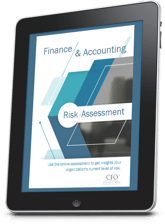
Being prepared for an economic downturn is fundamentally good advice. The economy is cyclical and eventually there will be a downturn of some sort. Preparation ultimately boils down to two basic business disciplines.
- Risk management. Do you actively practice a risk assessment process within your business? If you've not, it's something you should do. We have a resource that might be able to help. Finance & Accounting Risk Assessment
- The right metrics. You should evaluate how you are measuring your business and ensure that you have specific metrics that are forward-looking.
The one thing that derails most businesses when it comes to a downturn is, they're not looking far enough ahead early enough. They haven’t evaluated how they're going to be impacted by things that are happening around them.
They may have some insight within their own scope of data and content but aren't looking at it in a way that gives them some insight to say, “hey, we need to do something different.”
It can be as simple as forecasting your cash and getting a sense of the elements that drive the flow. It can be as sophisticated as doing a broad sweeping, strategic plan. The goal is to see the playing field and look at the variety of things that exist in your industry, with your competition and what's happening in the space that you occupy, all from a business perspective.
Doing a risk assessment (which is about the current moment in time) and looking forward into the future to ask “What do I think the future is going to change for me?” - those are the two biggest areas you need to concentrate on.
Unfortunately, when living in the day-to-day, many businesses don't concentrate on these two things enough to understand what's headed their way. With so many variables in the Pacific Northwest, many are struggling to know what the forward-looking piece is going to look like.
Like you, I prioritize meeting customer and stakeholder expectations. But evaluating how the business is operating while attending to those needs is critical to your ultimate success.
Future economy predictions and forecasts?
You may be able to do your own risk assessment and understand where things are today, but we keep hearing a narrative that intermittently suggests there is a macro economic downturn pending While at the same time, we are also hearing this may not be the case. Personally, I think we'll have slower growth from a macro standpoint in 2020, but things are not going to move into recessionary territory like we thought. The elements that were going to cause a downturn seem to have gone by the wayside. (At least for now.)
It doesn't mean you shouldn't be looking forward and answering the question, “what do I think the world's going to look like for us in the future?”
Many business owners try to rationalize not forecasting by thinking:
- My business is different.
- I can't forecast it.
- There's no point in going through that exercise.
If there's anything we've learned as an organization, it's that every business can be forecast. It's always a worthwhile exercise. You learn something every time you do it and you have to be disciplined about doing it regularly to understand how the future is going to impact you.
Different businesses can be forecast with more specificity depending on how much insight into the future they have. As a professional services firm:
- Our business isn't an easy one to look down the road on.
- Our next business opportunity is almost never known to us.
- We don't have the luxury of saying, “90 days from now or 180 days from now I'm going to do X.”
We forecast anyway.
Just about any business who has some form of widget sales or longer-term cycle to their business can at least get 90 days down the road with a great deal of certainty if not 180 days or a year or even two years depending on the specifics.
The downturn
While it may not happen in the next year, at some point the economy is going to turn. The more insight you have into the future, the more likely you are to craft a plan to prosper, regardless of economic conditions.
Instead of focusing on what to do if a downturn is happening, I prefer to focus on the likelihood that things are looking okay. We don’t want to raise a red flag and say: “Hey! The world is ending!” It is difficult to believe this will happen, especially in the Pacific Northwest.
What specifically can we look at to get more insight into the possible future? There are a handful of tools, and the ones you use will be based on your specific business.
Forecasting cash is a must for everybody.
Lagging indicators. Economists are big fans of lagging indicators because they think on a macro scale and data is diluted down enough to always be relevant. It's harder to predict from, but it's helpful if you are looking at it regularly. Vistage (a CEO Peer organization) is a huge proponent of suggesting that you use lagging indicators to think more deeply about what is down the road for your specific business.
Here is an example: Last year, for the first time, our first quarter was not our strongest quarter of the year. Because of the serious weather and snow in February, we were behind plan right out of the gate. Our first quarter was fine, but it was just okay. Business picked up again in the second quarter which became our strongest quarter from a financial standpoint. We went into summer expecting a downturn and August became a record month in terms of new opportunities. In the final quarter of the year we had a record-breaking October and followed by one of our lowest months in two years.
This example shows the importance of constantly evaluating business trends from multiple angles. The best forecast expert imaginable could not have predicted that series of events during the year. Were it not for our constant evaluation of results, and consistent updating of expectations, we could have been in trouble, ranging from unexpected cash issues to resource constraints, impacting our ability to serve clients.
Who is it within a company that should be involved in looking forward?
Businesses will tend to think their financial managers should be the one to do the financial projections. It certainly makes sense they would be responsible for gathering the information and confirm its accuracy, but it is really the divisional leaders within the business who are best positioned to bring clarity to this information. They are the ones who are operating the business, who have a good idea of what is going to happen. It is important for financial managers to be talking to the folks who have “boots on the ground” who know what is happening in the organization.
Which person will vary based on the size of a business. For a small business, it might be the chief executive him/herself. They are the one with the finger on the pulse of what is happening in the revenue cycle.
A larger business is usually going to have two, three, four, maybe 10 people that are included in that process. There are probably not going to be much more than 10, even in a $200 million company. They are going to have a good sense of what is happening. That information will be gathered by the chief financial executive and used to create a forecast.
Forecast components
The key elements of a forecast are revenue and margins. Revenue and margins can change dramatically and have the least amount of certainty because they are variable by definition. Overhead is probably the easiest piece to forecast and it should be included as well.
Let’s look at a sub-prime contractor as an example. They might have a backlog of work that goes out two years, so they should have a fairly accurate forecast of what the next one to two years will look like from a cash management standpoint. This, however, is not very common. Just about every other industry has a much shorter timeline associated with what they can predict. It could be as little as 60 to 90 days for a business which has difficultly knowing what the next opportunity will be.
To compensate for varying backlog levels, financial managers must commit to staying in touch with the business momentum, the staff, what the market looks like, the rate of incoming calls, etc. It is useful have an understanding of historical results, but it is a mistake to rely too heavily on history.
Evaluate a forecast based on industry factors?
As an example, in our business it does not matter which industry we serve because we get paid by the hour. A forecast is influenced by the commodity you are selling, which may or may not be dictated by an industry influence.
If you have products or services which are highly seasonal such as a company selling to crab boats or a similar situation, there are unusual things to account for in your forecast. By and large, industry doesn’t tend to be a significant factor. If you look at your client base or who you sell to in general, it may or may not have an industry element associated with it. Your forecast is going to be more about what your scope of influence is as a business.
Some businesses are industry specific with their accounting; most are not. Most tend to categorize revenue and expenses a little differently as they are internally oriented categorizations.
Advice when creating a forecast
It’s worth emphasizing: be careful not to confuse cash with non-cash. Be mindful of GAAP (Generally Accepted Accounting Principles), accrual based accounting and its influence on forecasting versus cash flow and its impact on forecasting. They are not the same. Most people understand this, but they don’t always think about the impact on cash, which is ultimately what you need to run your business.
If you think too much in the abstract about profitability and how you forecast profitability, it can lead you astray in terms of what your cash needs are. Particularly if you again think about the one-offs that may or may not be represented in the P&L.
For example, if you have a lot of debt service that you manage, that has a significant cash influence, but it does not necessarily indicate whether you are profitable or not. You can forecast profitability with a GAAP income statement and run out of cash tomorrow.
One additional important consideration stands out that needs to be allowed for, particularly for the Pacific Northwest. The availability of staff, recruiting and the unemployment rate are a significant factor for just about every business. You must be thinking about this when setting goals in 2020. This is a difficult issue to tackle, whether you are growing a business or not. You could very well lose people and may need to hire new staff to maintain the status quo.
Do you have questions or need help? Please contact us here!
 A financial risk assessment can make all the difference for your business. Preparing to take advantage of opportunities and eliminate potential landmines makes good business sense.
A financial risk assessment can make all the difference for your business. Preparing to take advantage of opportunities and eliminate potential landmines makes good business sense.
Get instant access to our free finance and accounting risk assessment!
About the Author
 Kevin Briscoe is the Executive Manager for CFO Selections. He is responsible for establishing and implementing goals and strategies for the firm. His professional career spans over 20 years in finance, accounting, and operations in publicly traded corporate and small, closely held settings.
Kevin Briscoe is the Executive Manager for CFO Selections. He is responsible for establishing and implementing goals and strategies for the firm. His professional career spans over 20 years in finance, accounting, and operations in publicly traded corporate and small, closely held settings.
Kevin excels in financial analyses and accounting operations, implementing internal controls, and creating and implementing organizational systems. He has held ownership and management positions, demonstrating an outstanding ability to provide effective leadership in increasing profitable growth throughout his career.






